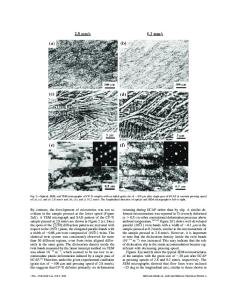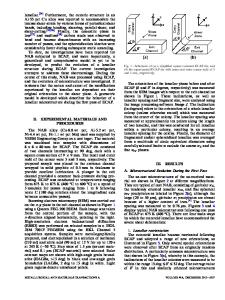Factors influencing the equilibrium grain size in equal-channel angular pressing: Role of Mg additions to aluminum
- PDF / 1,140,750 Bytes
- 8 Pages / 612 x 792 pts (letter) Page_size
- 121 Downloads / 309 Views
I.
INTRODUCTION
It is now established that ultrafine grain sizes, in the submicrometer or nanometer range, may be introduced into polycrystalline metals through the use of an intense plastic straining technique known as equal-channel angular (ECA) pressing.[1,2] In this procedure, a sample is pressed through a die in which two channels, equal in cross section, intersect at an angle of F, with an additional angle of C defining the arc of curvature at the outer point of the intersection of the two channels. The use of the ECA pressing technique has two advantages, in that it introduces no porosity into the material and it offers the potential for making large bulk samples. Earlier reports described the ECA pressing of pure Al,[3] an Al-3 pct Mg solid-solution alloy[4,5] and a commercial Al-Mg-Li-Zr alloy[6,7] to produce equilibrium grain sizes of ;1, ;0.2, and ;1.2 mm, respectively. The reason for these differences in the ultimate stable grain size is not understood at the present time, and the measured grain sizes appear not to correlate to the temperature of pressing because the pure Al and Al-3 pct Mg alloy were both pressed at room temperature whereas the Al-Mg-Li-Zr alloy was pressed at 673 K. Furthermore, Ferrasse et al.[8,9] pressed samples of CDA 101 oxygen-free copper and Al-3003 and Al-6061 alloys under identical conditions and reported achieving the same equilibrium grain sizes of ;0.2 to ;0.4mm in each material. From the limited results available to date, no firm conclusions can be reached concerning the factors which influence the ultimate stable grain sizes in ECA pressing experiments. YOSHINORI IWAHASHI, formerly Graduate Student with the Department of Materials Science and Engineering, Kyushu University, is Staff Engineer, Nagasaki Shipyard and Machinery Works, Mitsubishi Heavy Industries, Ltd., Fukahori, Nagasaki 851-03, Japan. ZENJI HORITA, Associate Professor, and MINORU NEMOTO, Professor, are with the Department of Materials Science and Engineering, Kyushu University, Fukuoka 812-8581, Japan. TERENCE G. LANGDON, Professor, is with the Departments of Materials Science and Mechanical Engineering, University of Southern California, Los Angeles, CA 90089-1453. Manuscript submitted December 30, 1997. METALLURGICAL AND MATERIALS TRANSACTIONS A
The present investigation was undertaken in order to provide information on the variation of the equilibrium grain size established by ECA pressing in samples of aluminum with Mg additions. Magnesium was selected as the alloying element because it is well known that the presence of Mg atoms reduces the dislocation mobility and introduces solidsolution strengthening, and this increase in strength is accompanied by little or no change in the overall ductility of the material.[10] In addition, the presence of Mg in solid solution gives rise to shear band formation during the cold rolling of aluminum,[11] and this may have important consequences when ECA pressing is performed at room temperature. II.
EXPERIMENTAL MATERIAL AND PROCEDURES
A. Materials Tests were un
Data Loading...











